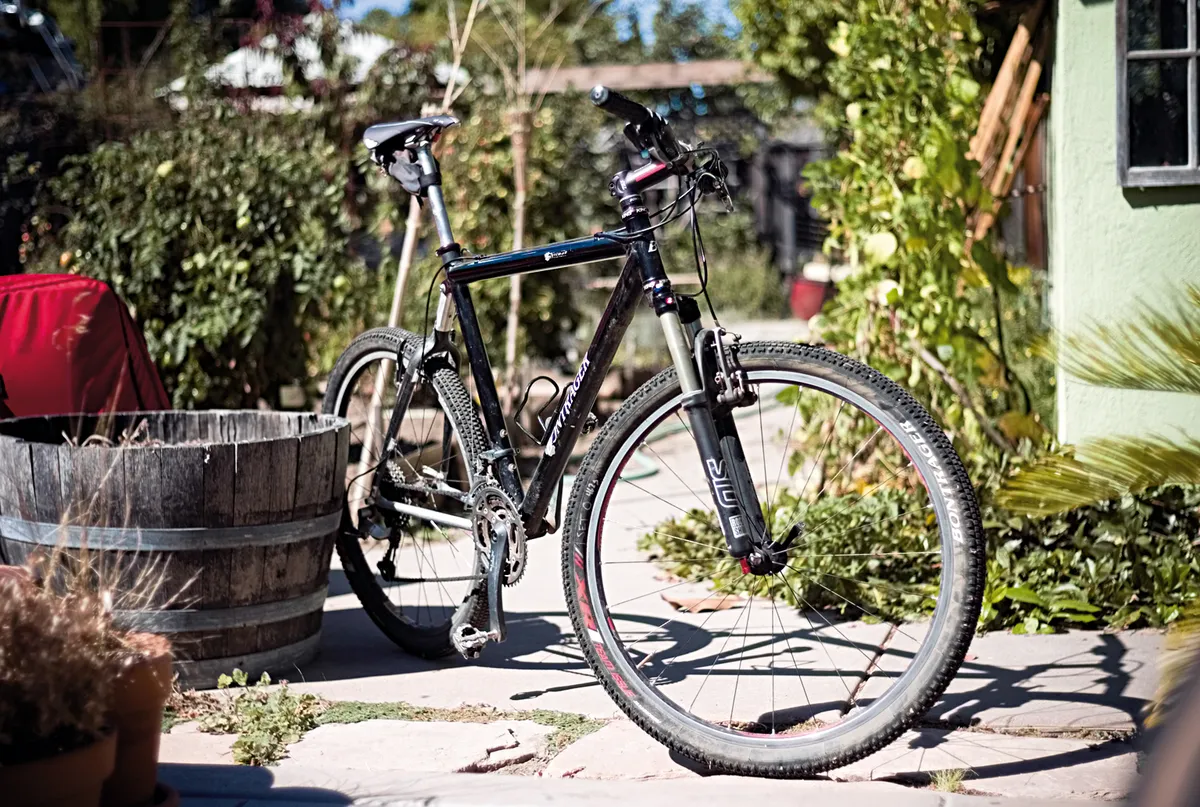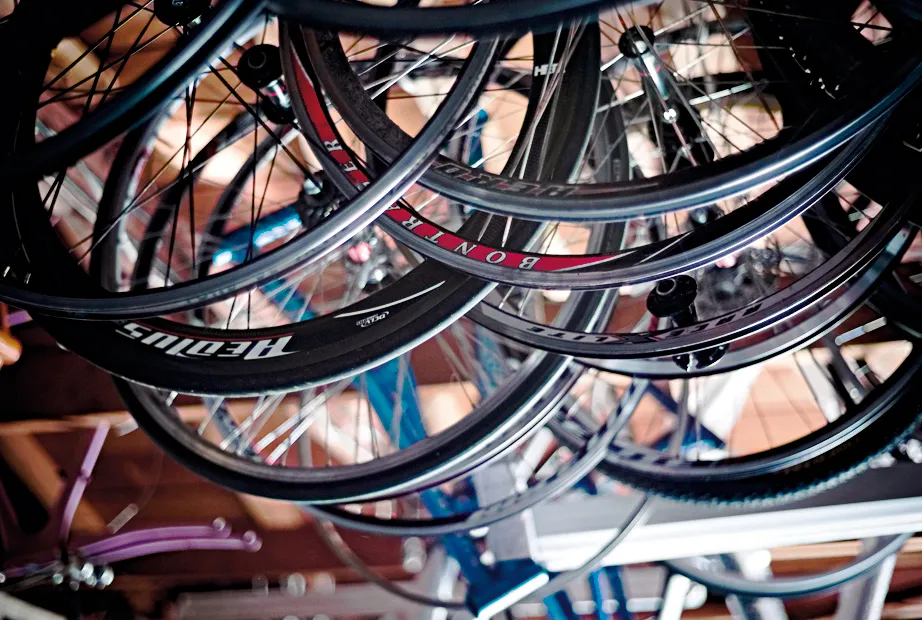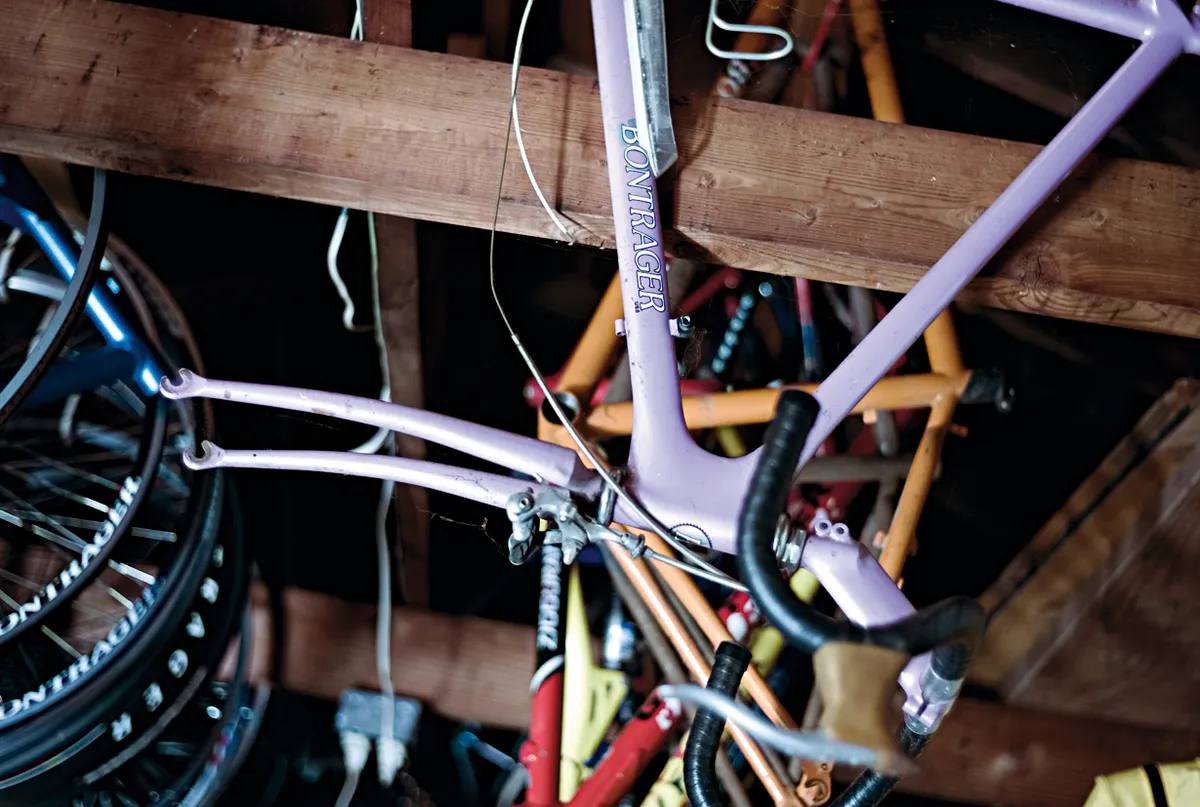It’s tomato plants that make Keith Bontrager’s bungalow stand out from his neighbours’: a garden given over to horticulture in a sea of tidy front lawns. It’s my first indication I’m about to meet a mind that’s prone to thinking outside the box.
But it’s bike components not tomatoes that are associated with the Bontrager name, and while the brand’s iconic ‘B’ decorates a hefty chunk of components on today’s Trek bikes, Keith first got noticed by hand-building frames in his garage in California.
Things have moved on in the intervening years, though, to the point that when I ask about his current role at Trek, Keith laughs. “Engineer at large would be the best description," he says. A moment later he adds: “Although there are some guys in Wisconsin [Trek’s HQ] that would like to hear my best shot at what my job description is!”
Ultimately, pioneering is what Keith does best. From the early days, he drew on his University College of Santa Cruz physics education and time as a motorbike mechanic to build better bikes. Keith still lives in Santa Cruz and continues to dig deep, often to a material level, to work out how his products can be improved.
We soon roll away from Keith’s house towards the two-hour loop that he uses to test components. The trails we ride are classic for the area: dusty and fast, and they crisscross the neighbouring hillsides with such regularity that the landscape must look like a giant tartan rug from the air.

Keith’s back yard is full of dusty trails that crisscross the surrounding countryside
Keith’s riding an ageing hardtail prototype that combines an aluminium main triangle, steel chainstays and a carbon wishbone, produced at a time when he was experimenting with using different materials for separate parts of the frame according to their suitability. It might sound like a Frankenstein creation, but it shows how the Bontrager mind works.
For Keith, it’s about evolving ideas and rethinking the accepted way of doing something. Of course, as with the mutant machine he’s using, not all are easily accepted in the outside world. “I’m often accused of inventing challenges,” he explains, “but in order to make something that will appeal to people, you have to find a new way of solving a problem to make it better.
"After all, how do you distinguish your brand riser bar from others? Sometimes you can’t, but there are times when you can do something better and it’s outside everyone’s comfort zone. I’m not saying you roll the dice, but if we do the extra work and we check out adifferent way and it works, then we have a better widget, whatever it might be.”

Keith’s materials experiment ‘Franken-bike’ is still going strong today
Bike fashion
Widgets. It’s a word that comes up often during our chat, serving as Keith’s catch-all phrase for the expanding range of Bontrager components. It was these widgets, rather than the beautiful hand-made frames Bontrager became famous for, that attracted Trek to buy the brand in 1995. Back then, Keith’s company was struggling to keep abreast of the largely fashion-led changes sweeping the market.
“We gave the bike brand a good shot. We had the most sophisticated steel manufacturing production line going, but steel hardtails were rapidly falling out of fashion and suspension bikes weren’t very good so we thought, ‘Why would you want one of those compared to a totally sorted ride?’” says Keith with little detectable hint of remorse. “At the time, the lesson to learn was that this wasn’t about riding a bike, but about fashion and the curiosity in new stuff."
For some time prior to Trek’s buyout, Keith had been producing components as a way of making mountain bikes truly suitable for off-road use. “The parts that were made according to traditional methods mostly broke, at least when you started riding them hard,” he explains, reminding me of the almost weekly broken rear-axle saga of my own first mountain bike.
Keith found himself at the forefront of a new industry pushing lighter yet stronger aftermarket componentry. With his background in modifying motorbikes, the step into this world was a natural progression.
Incorporation of the Bontrager B into a behemoth like Trek meant that certain compromises had to be made when it comes to Keith’s level of involvement. “I don’t run the company,” he explains chirpily. “I work on a lot of stuff, but I don’t have final say on much.” Indeed, with such a large team in product development, there are times when Keith arrives for a sales meeting and sees a Bontrager component for the first time.

Plenty of Bontrager products are tested by the head honcho himself
Yet rather than be vexed by this distancing from product development, Keith appears at ease with his position. “There is way too much going on for me to be involved in all of it,” he says.
But having your name etched on a range of products – some of which you’ve never seen, let alone had input into – must mean battling certain moral or egotistical demons? “Well, my association with the brand is still there, and we still have the same approach to what we do,” he explains, “but I don’t have any problem with the change down in spec for a lower price point product.
"You’d have to be dumb to think everything can be as good as high-end stuff. Frankly, the engineering for the £5,000 bike is more fun, you get to play with space-age materials, but the engineering for the £500 bike is more demanding because if you make a mistake there will be a lot of them coming back.”
Staying true
In truth, the man is still firmly associated with the Bontrager name. He’s the same engineer who’s been attributed the mantra “Light, strong, cheap – pick any two!” as a platform for understanding component manufacture. Bontrager production may have been ramped up massively under Trek, but Keith works by the same philosophies. Indeed, it’s unrealistic material expectations that stir the only glimmer of agitation from Keith during our chat, when I quiz him on the rebirth of carbon.
“The problem is the bike industry is full of people familiar with metal things that behave like metal things and now we’re making things that don’t behave like metal things. Some understand it and others don’t. The manufacturing is better than ever, but we’re not selling things that are used in a tight, well-controlled environment with predictable load ranges. We’re selling bikes to anybody who wants to ride – kids jumping 8ft high on bikes that are inexpensive, for example, and that shouldn’t happen…”

Keith used to make much-sought-after frames by hand
It would be easy to put Keith’s caution down to scepticism, but it’s really a product of his mechanical background. You see, Keith lived through the material revolution of the ’90s, when early carbon designs and certain alloys were being plugged as the next big thing, but few of them lived up to the hype.
“The first carbon bikes weren’t the optimal use of carbon fibre. The aerospace guys called it ‘black aluminium’, designing things out of carbon but using the same shapes and approaches as if it were aluminium. It doesn’t work. But you can see where it is now. People are designing carbon as if it is carbon. From the point of view of aperson who has spent most of their life making two wheel things go faster, all that is really cool. We’re getting Formula One-level stuff,” he adds with a grin, “for F1 prices.”
I’m guessing that today’s carbon offerings are a bit of an eye opener for a person who built his first frame through an unwillingness to pay for a road bike, and whose interest in growing his own vegetables stems from being “fundamentally cheap”. So as the technical side of our sport continues to develop rapidly and costs escalate, does Keith welcome the ‘no holds barred’ approach?
“The fact the mountain bike has this ‘do what you want’ attitude, and the fact that it’s riding not the racing that’s important is really good.” Then he refers me to the ’90s anodised CNC hubs, which were easy to make, but largely unreliable. “Trying these things is fine, but the bike industry is one where everyone who has an idea can give it a try… You can see all these really bad ideas in the patent office realised in hardware. It sounds snobby, but it’s part of physics and engineering to predict what will happen before you do it.”
After our ride, I ask Keith if he’s ever considered pulling his welding jig out of storage. “I have friends asking for [bikes]… I used to make a frame in a day, and not from sub-assemblies from Japan. This was [turning] bare tubes on the bench into finished frame. I used to like that. It’s like when I’m cooking now, when you get into this focused process [and] at the end of the day you have something to show for it.
"It’s the same motivation as looking at Italian frames and saying ‘I can do that’. It’s not just creativity: it’s craft. Ireally enjoy that part of it and since I don’t get to do it on bike parts any more, I turned to the kitchen.” With that, he hands me a bulging sandwich. The tomatoes in it are the best I’ve ever tasted.

Keith shows us the fruits of being “fundamentally cheap"
The life and times of Mr Bontrager
- 1954: Keith Bontrager is born.
- 1965: Keith’s love affair with both dirt and hands-on inventiveness begins when he constructs mini-motorbikes using lawnmower engines.
- 1970: After racing motocross events, Keith becomes chief tuner at the 250cc and 750cc World Champs, confirming his taste for speed and a fettle.
- 1979: Unwilling to pay for an Italian road bike, Keith builds his first frame. The plan is optimistic and the frame takes a year.
- 1980: Keith builds his second frame: a mountain bike. It’s loosely based on the Klunker template. He only makes one before incorporating more efficient angles for pedalling.
- 1980s: Operating out of his in-laws’ garage, Keith goes on to supply demand for further mountain bike, tandem and track frames.
- 1984: Keith finds some 40-hole 700c road bike rims in the bins outside the Specialized offices, cuts them down and re-rolls them into a 26in rim. The first seeds of Bontrager components are sown.
- 1986: Keith designs and produces the first clamped fork, where the fork legs are clamped into the crown rather than welded as a single unit. It’s this same design that forms the basis for almost every suspension fork today.
- 1993: Keith starts making quality components in far larger quantities.
- 1995: Keith’s no-faff approach to product design draws the attention of Trek. Wanting their own in-house component brand to offset their reliance on Shimano, Trek buy Bontrager.
- 1999: Bontrager turns out the Race Lite wheelsets, which are designed as a complete system.
- 2003: Lance Armstrong and the USPS cycling team ride Bontrager road wheels to Tour de France victory.
- 2004: Bontrager pioneers Tubeless Ready Technology.
